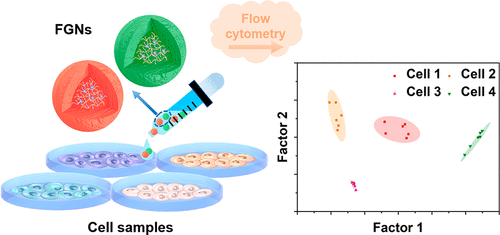当前位置:
X-MOL 学术
›
ACS Appl. Mater. Interfaces
›
论文详情
Our official English website, www.x-mol.net, welcomes your
feedback! (Note: you will need to create a separate account there.)
Cell Coding Arrays Based on Fluorescent Glycan Nanoparticles for Cell Line Identification and Cell Contamination Evaluation
ACS Applied Materials & Interfaces ( IF 8.3 ) Pub Date : 2021-09-09 , DOI: 10.1021/acsami.1c12674 Meng Cheng 1 , Lingshan Liu 1 , Peipei Zhang 1 , Shuhan Xiong 1 , Hongjing Dou 1
ACS Applied Materials & Interfaces ( IF 8.3 ) Pub Date : 2021-09-09 , DOI: 10.1021/acsami.1c12674 Meng Cheng 1 , Lingshan Liu 1 , Peipei Zhang 1 , Shuhan Xiong 1 , Hongjing Dou 1
Affiliation

|
Cell lines are applied on a large scale in the field of biomedicine, but they are susceptible to issues such as misidentification and cross-contamination. This situation is becoming worse over time due to the rapid growth of the biomedical field, and thus there is an urgent need for a more effective strategy to address the problem. As described herein, a cell coding method is established based on two types of uniform and stable glycan nanoparticles that are synthesized using the graft-copolymerization-induced self-assembly (GISA) method, which further exhibit distinct fluorescent properties due to elaborate modification with fluorescent labeling molecules. The different affinity between each nanoparticle and various cell lines results in clearly distinguishable differences in their endocytosis degrees, thus resulting in distinct characteristic fluorescence intensities. Through flow cytometry measurements, the specific signals of each cell sample can be recorded and turned into a map divided into different regions by statistical processing. Using this sensing array strategy, we have successfully identified six human cell lines, including one normal type and five tumor types. Moreover, cell contamination evaluation of different cell lines with HeLa cells as the contaminant in a semiquantitative analysis has also been successfully achieved. Notably, the whole process of nanoparticle fabrication and fluorescent testing is facile and the results are highly reliable.
中文翻译:

基于荧光聚糖纳米颗粒的细胞编码阵列用于细胞系鉴定和细胞污染评估
细胞系在生物医学领域得到了大规模应用,但容易出现误认、交叉污染等问题。由于生物医学领域的快速发展,这种情况随着时间的推移而变得更糟,因此迫切需要更有效的策略来解决这个问题。如本文所述,基于使用接枝共聚诱导自组装 (GISA) 方法合成的两种类型的均匀且稳定的聚糖纳米粒子建立了细胞编码方法,这些纳米粒子由于经过荧光修饰而进一步表现出不同的荧光特性标记分子。每个纳米颗粒与各种细胞系之间的不同亲和力导致它们的内吞程度明显不同,从而产生不同的特征荧光强度。通过流式细胞仪测量,可以记录每个细胞样本的特定信号,并通过统计处理将其转化为划分为不同区域的图谱。使用这种传感阵列策略,我们已经成功识别出六种人类细胞系,包括一种正常类型和五种肿瘤类型。此外,在半定量分析中,以 HeLa 细胞为污染物对不同细胞系的细胞污染评价也已成功实现。值得注意的是,纳米粒子制造和荧光测试的整个过程很容易,结果非常可靠。每个细胞样本的特定信号都可以被记录下来,并通过统计处理变成一个划分为不同区域的图。使用这种传感阵列策略,我们已经成功识别出六种人类细胞系,包括一种正常类型和五种肿瘤类型。此外,在半定量分析中,以 HeLa 细胞为污染物对不同细胞系的细胞污染评价也已成功实现。值得注意的是,纳米粒子制造和荧光测试的整个过程很容易,结果非常可靠。每个细胞样本的特定信号都可以被记录下来,并通过统计处理变成一个划分为不同区域的图。使用这种传感阵列策略,我们已经成功识别出六种人类细胞系,包括一种正常类型和五种肿瘤类型。此外,在半定量分析中,以 HeLa 细胞为污染物对不同细胞系的细胞污染评价也已成功实现。值得注意的是,纳米粒子制造和荧光测试的整个过程很容易,结果非常可靠。在半定量分析中,以 HeLa 细胞作为污染物对不同细胞系的细胞污染评估也已成功实现。值得注意的是,纳米粒子制造和荧光测试的整个过程很容易,结果非常可靠。在半定量分析中,以 HeLa 细胞作为污染物对不同细胞系的细胞污染评估也已成功实现。值得注意的是,纳米粒子制造和荧光测试的整个过程很容易,结果非常可靠。
更新日期:2021-09-22
中文翻译:

基于荧光聚糖纳米颗粒的细胞编码阵列用于细胞系鉴定和细胞污染评估
细胞系在生物医学领域得到了大规模应用,但容易出现误认、交叉污染等问题。由于生物医学领域的快速发展,这种情况随着时间的推移而变得更糟,因此迫切需要更有效的策略来解决这个问题。如本文所述,基于使用接枝共聚诱导自组装 (GISA) 方法合成的两种类型的均匀且稳定的聚糖纳米粒子建立了细胞编码方法,这些纳米粒子由于经过荧光修饰而进一步表现出不同的荧光特性标记分子。每个纳米颗粒与各种细胞系之间的不同亲和力导致它们的内吞程度明显不同,从而产生不同的特征荧光强度。通过流式细胞仪测量,可以记录每个细胞样本的特定信号,并通过统计处理将其转化为划分为不同区域的图谱。使用这种传感阵列策略,我们已经成功识别出六种人类细胞系,包括一种正常类型和五种肿瘤类型。此外,在半定量分析中,以 HeLa 细胞为污染物对不同细胞系的细胞污染评价也已成功实现。值得注意的是,纳米粒子制造和荧光测试的整个过程很容易,结果非常可靠。每个细胞样本的特定信号都可以被记录下来,并通过统计处理变成一个划分为不同区域的图。使用这种传感阵列策略,我们已经成功识别出六种人类细胞系,包括一种正常类型和五种肿瘤类型。此外,在半定量分析中,以 HeLa 细胞为污染物对不同细胞系的细胞污染评价也已成功实现。值得注意的是,纳米粒子制造和荧光测试的整个过程很容易,结果非常可靠。每个细胞样本的特定信号都可以被记录下来,并通过统计处理变成一个划分为不同区域的图。使用这种传感阵列策略,我们已经成功识别出六种人类细胞系,包括一种正常类型和五种肿瘤类型。此外,在半定量分析中,以 HeLa 细胞为污染物对不同细胞系的细胞污染评价也已成功实现。值得注意的是,纳米粒子制造和荧光测试的整个过程很容易,结果非常可靠。在半定量分析中,以 HeLa 细胞作为污染物对不同细胞系的细胞污染评估也已成功实现。值得注意的是,纳米粒子制造和荧光测试的整个过程很容易,结果非常可靠。在半定量分析中,以 HeLa 细胞作为污染物对不同细胞系的细胞污染评估也已成功实现。值得注意的是,纳米粒子制造和荧光测试的整个过程很容易,结果非常可靠。









































 京公网安备 11010802027423号
京公网安备 11010802027423号